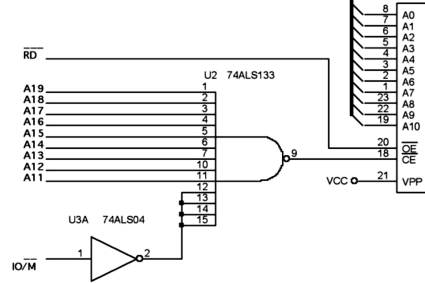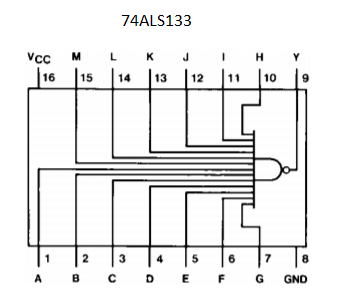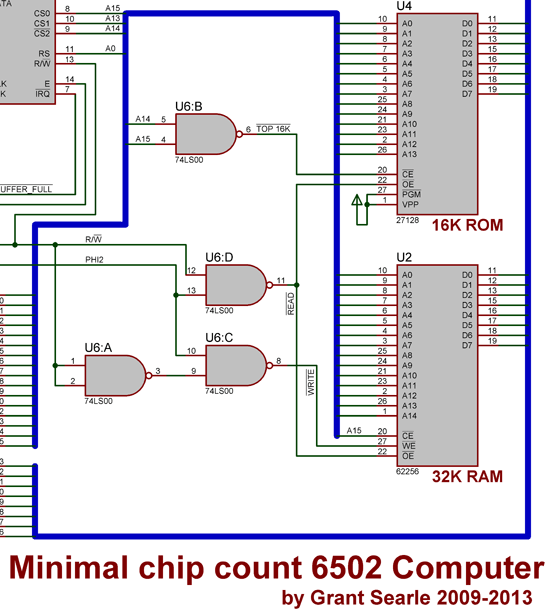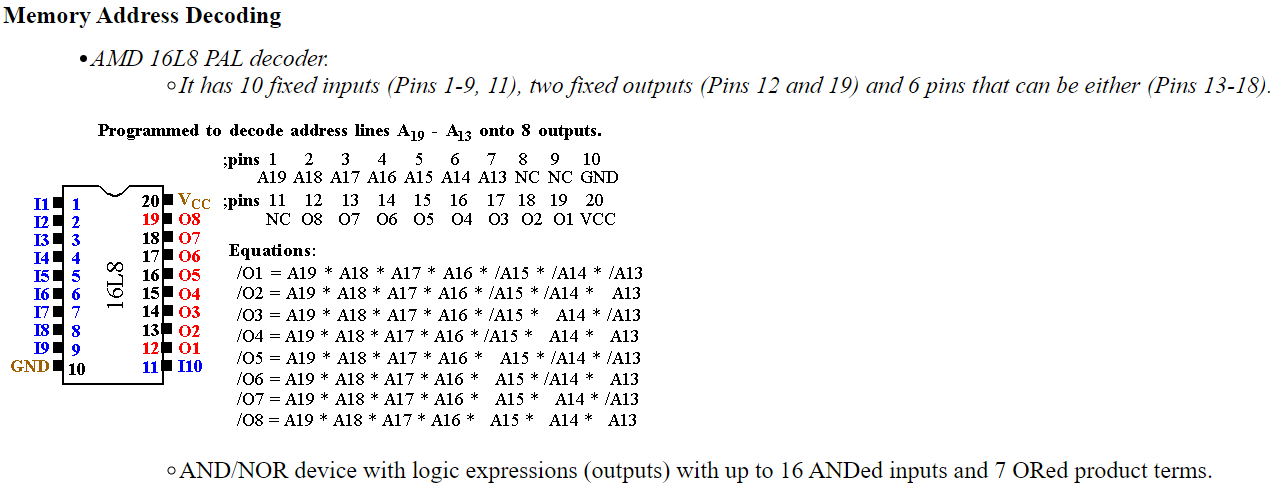Last Updated or created 2022-08-17
For accessing the different components in computers you have to use the Address Bus.
In most 8 bits computers there are 16 address lines.
The CPU on a 6502 can access 65536 addresses (16 bit ). But most chips in the circuit have just a few address lines.
So the chip to use has to be selected using a CE (chip Enable) signal.
Old article i found on my fileserver from 1984
74 Series logic
Above example uses A15 combined with A14 to address the 16K ROM
When using a 32k rom in the upper part of the memory, a15 can be used as CE


The 74ALS133 is a widely used decoder due to it’s many inputs.
Sometimes not all address lines are used for decoding, then you will get a repetition of the device in the memory map.
Above 6522 VIA has only 4 address lines RS0-RS3. But 2 chipselect pins (CS).
If you connect the chip as below.
A15 A14 A13 A12 A11 A10 A09 A08 A07 A06 A05 A04 A03 A02 A01 A00
CS1 CS2 NC NC NC NC NC NC NC NC NC NC CR3 CR2 CR1 CR0
(NC - not connected, and CS2 is inverted!)The chip would be selected when A15 is 1 and A14 is 0, A13-A04 it would not listen to. So its 4 bits addresses (total 16), would be repeated in a block $8000-$BFFF (10xx xxxx xxxx aaaa) 16384 addresses for 16 addresses on the 6522
ROM
Another simple solution to get a more precise address decoder without using a lot of components is using a ROM.
But this wil only work for low speeds!
A eeprom is relative cheap
PAL PLA GAL
With these devices you can “program” a schematic which works as above example’s of the 74 series. But now you can do it using only one component.
PALs and PLAs are fuse-programmed, some are erasable like (e)eprom.
Below a example of the code.
Most of the PAL/PLA/GAL are hard to get and obsolete
;PALASM Design Description ;---------------------------------- Declaration Segment ------------ TITLE pRAM PC_interface Address Decoder PATTERN pRAM97A.pds REVISION H AUTHOR Trevor Clarkson COMPANY EEE KCL DATE 30/05/97 CHIP decode PALCE20V8 ;---------------------------------- PIN Declarations --------------- PIN 1 AEN COMBINATORIAL ; INPUT PIN 2 A9 COMBINATORIAL ; INPUT PIN 3 A8 COMBINATORIAL ; INPUT PIN 4 A7 COMBINATORIAL ; INPUT PIN 5 A6 COMBINATORIAL ; INPUT PIN 6 A5 COMBINATORIAL ; INPUT PIN 7 A4 COMBINATORIAL ; INPUT PIN 8 A3 COMBINATORIAL ; INPUT PIN 9 A2 COMBINATORIAL ; INPUT PIN 10 A1 COMBINATORIAL ; INPUT PIN 11 IOW COMBINATORIAL ; INPUT PIN 12 GND PIN 13 IOR COMBINATORIAL ; INPUT PIN 14 ACK_HALT COMBINATORIAL ; INPUT PIN 15 PLS_EN COMBINATORIAL ; OUTPUT PIN 16 BRDW COMBINATORIAL ; OUTPUT PIN 17 MOD_CTRL COMBINATORIAL ; OUTPUT PIN 18 RAM_ACCESS COMBINATORIAL ; OUTPUT PIN 19 IO_16 COMBINATORIAL ; OUTPUT PIN 20 LATCH_MOD COMBINATORIAL ; OUTPUT PIN 21 LATCH_ADD COMBINATORIAL ; OUTPUT PIN 22 P300 COMBINATORIAL ; OUTPUT PIN 23 P300IN COMBINATORIAL ; INPUT PIN 24 VCC ;PC address decoding functions (not all in this PAL) ;uses latched address to provide low-order address lines to pRAM/RAM ; A3 A2 A1 R/W Addr Function ; 0 0 0 R 300 MFF_0 ; W not used ; 0 0 1 R 302 MFF_1 ; W not used ; 0 1 0 R 304 MFF_2 ; W not used ; 0 1 1 R 306 MFF_3 ; W Latch Module Number ; 1 0 0 R 308 PLS_Status (pRAM status) ; W PLS_Control (pRAM control) ; 1 0 1 R 30A Weight/Connection- ; W Pointer RAM access ; 1 1 0 R 30C not used ; W Latched RAM address ; 1 1 1 R 30E not used ; W pRAM_256 module control ; ; NB. IO_16 must be tri-stated when not in use ;----------------------------------- Boolean Equation Segment ------ EQUATIONS /P300 = A9*A8*/A7*/A6*/A5*/A4*/IOR + A9*A8*/A7*/A6*/A5*/A4*/IOW /BRDW = /P300IN * /IOW /PLS_EN = /P300IN*/A3*/IOR + /P300IN*A3*/A2*/A1 ; MOD_CTRL is active HIGH MOD_CTRL = ACK_HALT * /BRDW * A3 * A2 * A1 * /IOW ; RAM_ACCESS is active HIGH RAM_ACCESS = ACK_HALT * /P300IN * A3 * /A2 * A1 IO_16 = GND IO_16.TRST = /P300IN ; enable 16-bit transfers ; LATCH_MOD is active HIGH LATCH_MOD = /BRDW * /A3 * A2 * A1 ; LATCH_ADD is active HIGH LATCH_ADD = /BRDW * A3 * A2 * /A1 ;----------------------------------- Simulation Segment ------------ SIMULATION TRACE_ON A9 A8 A7 A6 A5 A4 IOR /IOW /BRDW /PLS_EN MOD_CTRL RAM_ACCESS IO_16 LATCH_MOD LATCH_ADD ACK_HALT /P300 /P300IN SETF /A9 /A8 /A7 /A6 /A5 /A4 /A3 /A2 /A1 IOR IOW /ACK_HALT /P300IN SETF /IOW ; test P300 doesn't respond SETF IOW /IOR ; test P300 doesn't respond SETF IOR SETF A9 A8 /A7 /A6 /A5 /A4 /IOR /P300IN SETF A1 SETF A2 /A1 SETF A1 ; read mff0-3 SETF IOR /IOW ; test P300 and BRDW SETF /A3 A2 A1 ; test Latch Module No SETF IOW A3 A2 A1 ; MOD-CTRL not active until ACK_HALT SETF ACK_HALT /IOW SETF IOW /ACK_HALT SETF A3 /A2 A1 ; check RAM_ACCESS SETF ACK_HALT /IOW SETF /ACK_HALT IOW SETF ACK_HALT /IOR ; check READ and WRITE to RAM SETF IOR P300IN SETF /A3 A2 A1 SETF /ACK_HALT /P300IN SETF IOW SETF /A3 A2 A1 /IOW ; check LATCH_MOD SETF IOW SETF A3 A2 /A1 SETF /IOW ; check LATCH_ADD SETF /A3 /A2 /A1 ; shouldn't happen normally TRACE_OFF ;-------------------------------------------------------------------
FPGA
Example FPGA code. A solution which is too fancy for my 6502.// Verilog code for decoder
// 5-input AND gate
module AND_5_input(g,a,b,c,d,e);
output g;
input a,b,c,d,e;
and #(50) and1(f1,a,b,c,d),
and2(g,f1,e);
endmodule
// fpga4student.com: FPGA projects, Verilog projects, VHDL projects
// Verilog code for decoder
// Decoder top level Verilog code using 5-input AND gates
module dec5to32(Out,Adr);
input [4:0] Adr; // Adr=Address of register
output [31:0] Out;
not #(50) Inv4(Nota, Adr[4]);
not #(50) Inv3(Notb, Adr[3]);
not #(50) Inv2(Notc, Adr[2]);
not #(50) Inv1(Notd, Adr[1]);
not #(50) Inv0(Note, Adr[0]);
AND_5_input a0(Out[0], Nota,Notb,Notc,Notd,Note); // 00000
AND_5_input a1(Out[1], Nota,Notb,Notc,Notd,Adr[0]); // 00001
AND_5_input a2(Out[2], Nota,Notb,Notc,Adr[1],Note); //00010
AND_5_input a3(Out[3], Nota,Notb,Notc,Adr[1],Adr[0]);
AND_5_input a4(Out[4], Nota,Notb,Adr[2],Notd,Note);
AND_5_input a5(Out[5], Nota,Notb,Adr[2],Notd,Adr[0]);
AND_5_input a6(Out[6], Nota,Notb,Adr[2],Adr[1],Note);
AND_5_input a7(Out[7], Nota,Notb,Adr[2],Adr[1],Adr[0]);
AND_5_input a8(Out[8], Nota,Adr[3],Notc,Notd,Note);
AND_5_input a9(Out[9], Nota,Adr[3],Notc,Notd,Adr[0]);
AND_5_input a10(Out[10], Nota,Adr[3],Notc,Adr[1],Note);
AND_5_input a11(Out[11], Nota,Adr[3],Notc,Adr[1],Adr[0]);
AND_5_input a12(Out[12], Nota,Adr[3],Adr[2],Notd,Note);
AND_5_input a13(Out[13], Nota,Adr[3],Adr[2],Notd,Adr[0]);
AND_5_input a14(Out[14], Nota,Adr[3],Adr[2],Adr[1],Note);
AND_5_input a15(Out[15], Nota,Adr[3],Adr[2],Adr[1],Adr[0]);
AND_5_input a16(Out[16], Adr[4],Notb,Notc,Notd,Note);
AND_5_input a17(Out[17], Adr[4],Notb,Notc,Notd,Adr[0]);
AND_5_input a18(Out[18], Adr[4],Notb,Notc,Adr[1],Note);
AND_5_input a19(Out[19], Adr[4],Notb,Notc,Adr[1],Adr[0]);
AND_5_input a20(Out[20], Adr[4],Notb,Adr[2],Notd,Note);
AND_5_input a21(Out[21], Adr[4],Notb,Adr[2],Notd,Adr[0]);
AND_5_input a22(Out[22], Adr[4],Notb,Adr[2],Adr[1],Note);
AND_5_input a23(Out[23], Adr[4],Notb,Adr[2],Adr[1],Adr[0]);
AND_5_input a24(Out[24], Adr[4],Adr[3],Notc,Notd,Note);
AND_5_input a25(Out[25], Adr[4],Adr[3],Notc,Notd,Adr[0]);
AND_5_input a26(Out[26], Adr[4],Adr[3],Notc,Adr[1],Note);
AND_5_input a27(Out[27], Adr[4],Adr[3],Notc,Adr[1],Adr[0]);
AND_5_input a28(Out[28], Adr[4],Adr[3],Adr[2],Notd,Note);
AND_5_input a29(Out[29], Adr[4],Adr[3],Adr[2],Notd,Adr[0]);
AND_5_input a30(Out[30], Adr[4],Adr[3],Adr[2],Adr[1],Note);
AND_5_input a31(Out[31], Adr[4],Adr[3],Adr[2],Adr[1],Adr[0]); // 11111
endmodule
Example of Ice studio FPGA programming


Conslusion:
For now i will use the 74 logic. But i definitely will revisit FPGA’s




